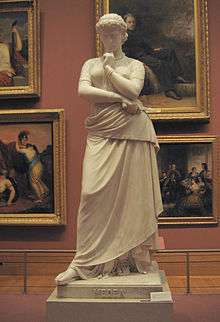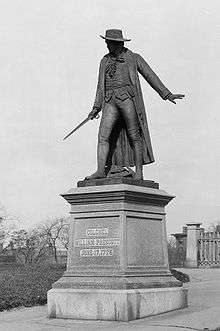William Wetmore Story

William Wetmore Story (February 12, 1819 – October 7, 1895) was an American sculptor, art critic, poet, and editor.
Life and career

William Wetmore Story was the son of jurist Joseph Story and Sarah Waldo (Wetmore) Story. He graduated at Harvard College in 1838 and at the Harvard Law School in 1840, continued his law studies under his father, was admitted to the Massachusetts bar, and prepared two legal treatises of value — Treatise on the Law of Contracts not under Seal (2 vols., 1844) and Treatise on the Law of Sales of Personal Property (1847).[1]
Abandoning the law, he devoted himself to sculpture, and after 1850 lived in Rome, whither he had first gone in 1848, and where he was intimate with the Brownings and with Walter Savage Landor. In 1856, he received a commission for a bust of his late father, which resides in the Memorial Hall/Lowell Hall. Story's apartment, in Palazzo Barberini, became a central location for Americans in Rome. During the American Civil War his letters to the Daily News in December 1861 (afterwards published as a pamphlet, “The American Question,” i.e. of neutrality), and his articles in Blackwood's, had considerable influence on English opinion.[1]
One of his most famous works, Cleopatra, (1858) was described and admired in Nathaniel Hawthorne's romance, The Marble Faun,[1] and is on display at the Virginia Museum of Fine Arts in Richmond, Virginia. Another work, the Angel of Grief, has been replicated near the Stanford Mausoleum at Stanford University. Among his other life-size statues he completed were those of Saul; Sapho: Electra; Semiramide; Delilah; Judith; Medea; Jerusalem Desolate; Sardanapolis; Solomon, Orestes; Canidia, and Shakespeare. His Sibyl and Cleopatra were exhibited at the 1863 Universal Exposition in London.[2]
Story submitted a design for the Washington Monument, then under construction. Although the Washington National Monument Society concluded that his design seemed "vastly superior in artistic taste and beauty" to the obelisk already under construction, the obelisk continued to be built, and is what we see today as the monument. In addition, Story sculpted a bronze statue of Joseph Henry on the Mall in Washington, D.C., the scientist who served as the Smithsonian Institution's first Secretary. His works Libyan Sibyl, Medea and Cleopatra are on display at the High Museum of Art in Atlanta, GA.
Story died at Vallombrosa Abbey, Italy; a place to which he had a sentimental attachment, and which he chronicled in an informal travel journal, Vallombrosa in 1881. He is buried with his wife, Emelyn Story, in the Protestant Cemetery, Rome, under a statue of his own design (Angel of Grief). A posthumous biography of Wetmore (and his circle), entitled William Wetmore Story and His Friends, was penned by Henry James.
Family
His children also pursued artistic careers: Thomas Waldo Story (1855–1915) became a sculptor, Julian Russell Story (1857–1919) was a successful portrait painter, and Edith Marion (1844–1907), the marchesa Peruzzi de' Medici, became a writer.
Selected works
- Statue of George Peabody next to the Royal Exchange, London, 1869. A replica, erected in 1890, stands next to the Peabody Institute, Mount Vernon Park, Baltimore, Maryland.
- Joseph Henry Memorial, Washington D.C., 1883
- John Marshall Memorial, Washington D.C., 1884
- Angel of Grief, 1894, monument to his dead wife.
- Statue of Joseph Story, his father, in Harvard Law School's Langdell Hall
Selected writings
- Life and Letters of Joseph Story, 1851
- Wetmore Story, William (1863). Roba di Roma Volume 1. Fourth Edition, 1864, D. Appleton and Company, New York. (A collection of contemporary observations of Rome.)
- Proportions of the Human Figure, London, 1864
- Fiammetta, 1885 (a novel)
- Conversations in a Studio, Boston, 1890
- Excursions in Art and Letters, Boston, 1891
- His poems were collected in two volumes in 1885. Among the longer are “A Roman Lawyer in Jerusalem” (a rehabilitation of Judas Iscariot), “A Jewish Rabbi in Rome,” Tragedy of Nero” (1872) and “Ginevra di Siena.” The last named, with “Cleopatra,” was included in his Graffiti d'Italia, a collection published in 1868.
Images



- George Peabody, London


References
- 1 2 3 Chisholm 1911.
- ↑ Dizionario degli Artisti Italiani Viventi: pittori, scultori, e Architetti., by Angelo de Gubernatis. Tipe dei Successori Le Monnier, 1889, page 498.
![]() Chisholm, Hugh, ed. (1911). "Story, William Wetmore". Encyclopædia Britannica (11th ed.). Cambridge University Press.
Chisholm, Hugh, ed. (1911). "Story, William Wetmore". Encyclopædia Britannica (11th ed.). Cambridge University Press.
Sources
- Phillips, M., Reminiscences of William Wetmore Story, the American Sculptor and Author, Chicago, 1897
- James, H., William Wetmore Story and his Friends, 2 vols, London, 1903
- Thomas Waldo Story (1855-1915)
- William W. Story, 'Vallombrosa', Firenze: Clinamen, 2002.
- The lure of Italy. American Artists and the Italian Experience, ed. by Theodore E. Stebbins, Jr., Museum of Fine Arts, Boston, 1992, pp. 19, 25, 27, 46, 58, 63- 64 and passim.
External links
![]() Media related to William Wetmore Story at Wikimedia Commons
Media related to William Wetmore Story at Wikimedia Commons
![]() Quotations related to William Wetmore Story at Wikiquote
Quotations related to William Wetmore Story at Wikiquote
- Works by William Wetmore Story at Project Gutenberg
- Works by or about William Wetmore Story at Internet Archive
- Works by William Wetmore Story at LibriVox (public domain audiobooks)

- Poems at sonnets.org
- William Wetmore Story at Find a Grave